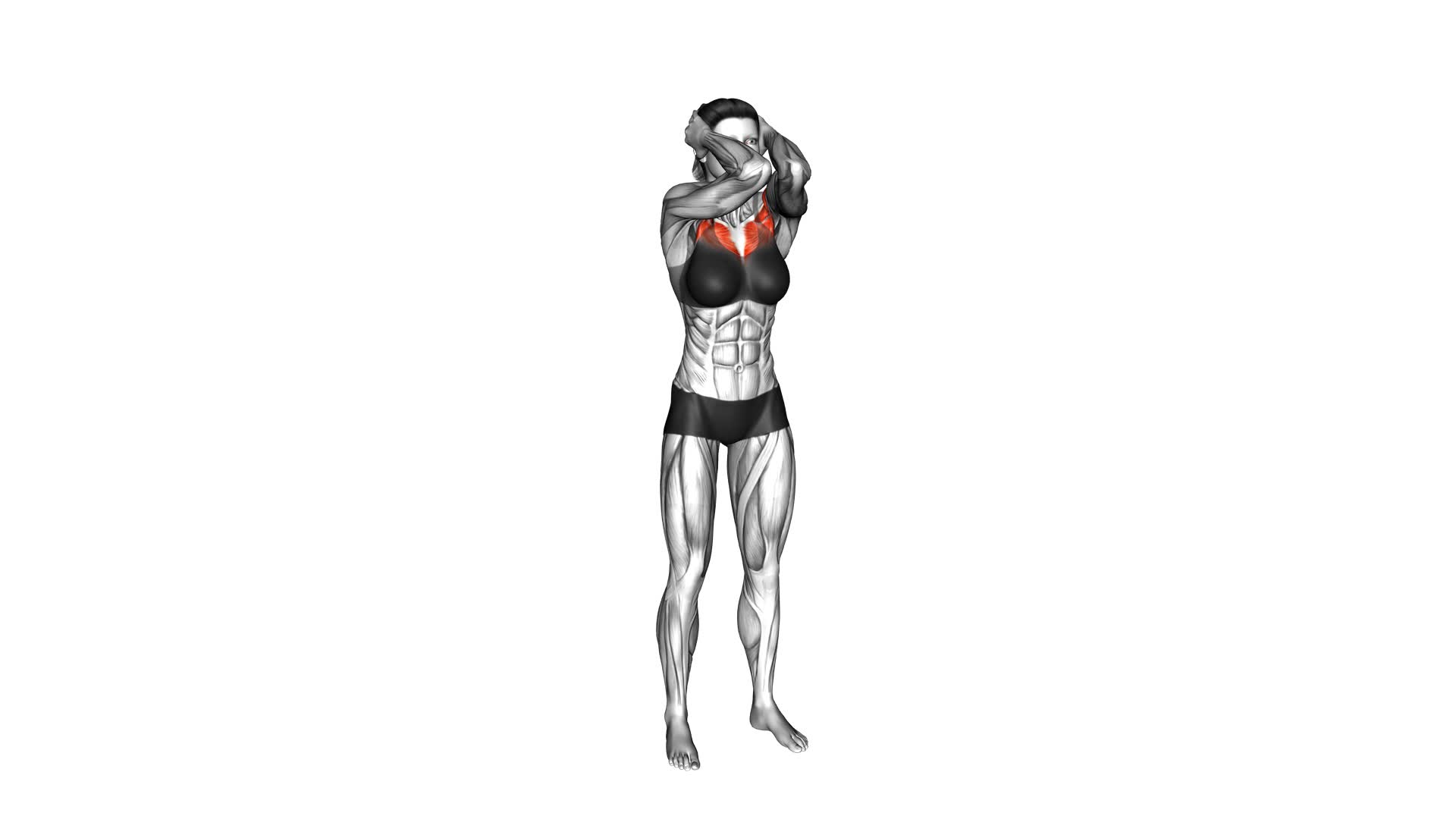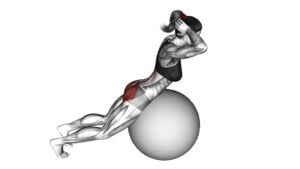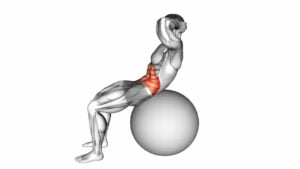Hands Behind Head Chest Squeeze (female) – Video Exercise Guide & Tips

Looking to tone your chest muscles? Get ready to try the hands behind head chest squeeze exercise!
Watch This Exercise Video
This video exercise guide and tips will show you the proper form and technique to effectively target your chest. Whether you're a beginner or a fitness pro, there are modifications and progressions for all levels.
Avoid common mistakes and learn how to incorporate this exercise into your workout routine for maximum results.
Let's get started!
Key Takeaways
- The Hands Behind Head Chest Squeeze targets the pectoralis major and pectoralis minor muscles.
- It promotes strength and definition in the chest.
- This exercise can be modified for different fitness levels and variations can be used to target different areas of the chest.
- Proper form, alignment, and stability are crucial for maximum results and to avoid common mistakes.
Benefits of the Hands Behind Head Chest Squeeze
To experience the benefits of the Hands Behind Head Chest Squeeze exercise, start by positioning yourself on a flat surface with your knees bent and a dumbbell in each hand. This exercise primarily targets the muscles in your chest, specifically the pectoralis major and pectoralis minor. By squeezing your hands together behind your head, you engage these muscles and promote strength and definition in your chest.
To increase the intensity of the Hands Behind Head Chest Squeeze, there are a few modifications you can make. First, you can increase the weight of the dumbbells you're using. This will add more resistance and challenge your muscles further. Additionally, you can perform the exercise on an incline bench. This will change the angle of your body and increase the difficulty of the exercise. Finally, you can slow down the movement and focus on the contraction of your chest muscles. This will require more control and effort, resulting in a more intense workout.
Equipment Needed for the Exercise
You will need dumbbells for the Hands Behind Head Chest Squeeze exercise. This exercise focuses on the chest muscles and can be performed with various variations to target different areas of the chest.
To perform the exercise, lie on your back on a bench with your feet flat on the floor. Hold a dumbbell in each hand, with your palms facing towards your feet. Bend your elbows and bring your hands behind your head, keeping your upper arms parallel to the floor. From this position, squeeze your chest muscles and push the dumbbells upwards until your arms are fully extended. Slowly lower the dumbbells back to the starting position and repeat for the desired number of repetitions.
When it comes to choosing the right dumbbell weight for the Hands Behind Head Chest Squeeze exercise, it's important to start with a weight that challenges you but still allows you to maintain proper form throughout the movement.
As a general guideline, beginners may start with lighter weights, such as 2-5 pounds, while more advanced individuals can use heavier weights, such as 8-15 pounds. It's always recommended to gradually increase the weight as you become stronger and more comfortable with the exercise.
Proper Form and Technique for the Exercise
To perform the Hands Behind Head Chest Squeeze exercise with proper form and technique, it's essential to focus on alignment and body positioning. Keep your back straight, shoulders relaxed, and engage your core throughout the movement.
Additionally, remember to breathe in a controlled manner, exhaling as you squeeze your chest muscles.
Alignment and Body Positioning
Position your body with your hands placed firmly behind your head for the Hands Behind Head Chest Squeeze exercise. Proper alignment and body positioning are crucial for effective workouts and to prevent injuries. Here are three key points to remember:
- Importance of alignment in exercise:
- Align your head, neck, and spine in a neutral position to maintain proper posture and reduce strain on your neck and back.
- Keep your shoulders relaxed and avoid hunching forward to engage the correct muscles and maximize the effectiveness of the exercise.
- Correct body positioning for effective workouts:
- Plant your feet firmly on the ground, shoulder-width apart, to ensure stability and balance.
- Engage your core muscles by drawing your belly button towards your spine, creating a strong foundation for the exercise.
- Maintain a slight bend in your knees to avoid locking them and to protect your joints.
Breathing During the Exercise
During the Hands Behind Head Chest Squeeze exercise, focus on maintaining proper breathing technique to enhance the effectiveness of the workout.
Proper breathing is essential in any exercise as it helps deliver oxygen to your muscles and improves overall performance. It also helps prevent dizziness or lightheadedness during the exercise.
To ensure proper breathing, inhale deeply through your nose as you lower your chest towards the ground and exhale through your mouth as you squeeze your chest muscles. Take slow and controlled breaths, avoiding shallow or rapid breathing.
This will help you maintain stability and control throughout the exercise.
Modifications and Progressions for All Fitness Levels
You can modify and progress the Hands Behind Head Chest Squeeze exercise to suit your fitness level. Here are three ways to do so:
- Range of Motion: If you're a beginner or have limited flexibility, you can start by performing smaller movements. Instead of bringing your elbows all the way back, simply squeeze your shoulder blades together as much as you comfortably can. As you become more comfortable and flexible, gradually increase your range of motion.
- Resistance: To make the exercise more challenging, you can add resistance by holding a dumbbell or resistance band between your hands. This will engage your chest muscles even more and help you build strength. Start with a light weight or band resistance and gradually increase it as you get stronger.
- Stability: To work on your core stability and balance, you can perform the exercise on a stability ball or a Bosu ball. This will engage your core muscles as you squeeze your chest together. Make sure to maintain proper form and stability throughout the exercise.
Common Mistakes to Avoid During the Exercise
Avoiding these mistakes is crucial for proper execution of the Hands Behind Head Chest Squeeze exercise. To ensure that you get the most out of this exercise and avoid any potential injuries, it's important to be aware of common mistakes and maintain proper form throughout.
One common mistake is using too much momentum. Remember, this exercise is all about controlled movements. Avoid swinging your body or jerking your arms to generate momentum. Instead, focus on using your chest muscles to squeeze your hands together, engaging them fully.
Another mistake to avoid is arching your back excessively. It's important to maintain a neutral spine throughout the exercise. Arching your back not only puts unnecessary strain on your lower back but also takes away from the effectiveness of the exercise. Keep your core engaged and your back straight.
Lastly, be mindful of your hand placement. Make sure your hands are securely behind your head, with your fingers interlaced. Avoid placing your hands too high up on your head or allowing them to slide forward during the exercise. This ensures that your chest muscles are the primary focus of the movement.
Tips for Incorporating the Hands Behind Head Chest Squeeze Into Your Workout Routine
To incorporate the Hands Behind Head Chest Squeeze into your workout routine, it's helpful to focus on maintaining proper form and engaging your chest muscles throughout the exercise. Here are some tips to help you effectively incorporate this exercise into your routine:
- Start with proper form:
Stand tall with your feet shoulder-width apart and your core engaged. Bend your elbows and place your hands behind your head, with your fingertips touching the base of your skull. Keep your elbows wide and your chest lifted throughout the exercise.
- Squeeze your chest muscles:
As you bring your elbows forward, squeeze your chest muscles and imagine bringing them together in the center of your chest. This will help maximize muscle activation and ensure you're targeting the right area.
- Incorporate variations:
Once you have mastered the basic Hands Behind Head Chest Squeeze, you can add variations to make the exercise more challenging. You can try using dumbbells or resistance bands to add resistance, or you can perform the exercise on an incline or decline bench to target different areas of your chest.
Frequently Asked Questions
How Many Repetitions and Sets Should I Do for the Hands Behind Head Chest Squeeze Exercise?
To get the most out of the hands behind head chest squeeze exercise, it's important to find the right balance of repetitions and sets. While the ideal number can vary depending on your fitness level and goals, a general guideline is to aim for 8-12 repetitions and 2-3 sets. This will help target and strengthen your chest muscles effectively.
The hands behind head chest squeeze exercise offers numerous benefits, including improved upper body strength and posture.
Can the Hands Behind Head Chest Squeeze Exercise Help Improve Posture?
The hands behind head chest squeeze exercise is a great addition to your workout routine. Not only does it target your chest muscles, but it can also help improve your posture.
By squeezing your chest muscles and keeping your hands behind your head, you engage your upper back muscles, which can help strengthen and stabilize your posture.
Make sure to perform the exercise with proper form for maximum effectiveness and benefits.
What Muscles Are Targeted During the Hands Behind Head Chest Squeeze Exercise?
During the hands behind head chest squeeze exercise, several muscles are targeted. These include the pectoralis major, which is responsible for chest development, and the deltoids, which help with shoulder movement. Additionally, the trapezius muscles in the upper back are engaged, along with the biceps and triceps in the arms.
This exercise offers benefits such as improved upper body strength and posture. Variations of the exercise can be performed using different equipment or positions to target the muscles in slightly different ways.
Can the Hands Behind Head Chest Squeeze Exercise Help Reduce Back Pain?
To reduce back pain, the hands behind head chest squeeze exercise can be beneficial. This exercise targets the chest muscles while also engaging the back muscles, which can help improve posture and alleviate discomfort.
To perform the exercise correctly, start by standing with your feet shoulder-width apart and your hands clasped behind your head. Then, squeeze your shoulder blades together while keeping your elbows wide.
For beginners, modifications or variations can include using lighter weights or performing the exercise against a wall for added support.
Is It Necessary to Use Weights or Resistance Bands for the Hands Behind Head Chest Squeeze Exercise?
You don't necessarily need to use weights or resistance bands for the hands behind head chest squeeze exercise. There are alternative variations that you can try, such as using dumbbells or a stability ball.
Incorporating this exercise into your full body workout routine can have several benefits. It helps to strengthen your chest, shoulders, and triceps while also engaging your core muscles.
Plus, it can improve your posture and promote better upper body alignment.
Conclusion
The hands behind head chest squeeze is a beneficial exercise for strengthening the chest muscles. It requires minimal equipment and can be modified for all fitness levels.
Proper form and technique are crucial to avoid common mistakes.
By incorporating this exercise into your workout routine, you can improve your upper body strength and overall fitness.

Author
Years ago, the spark of my life’s passion ignited in my mind the moment I stepped into the local gym for the first time. The inaugural bead of perspiration, the initial endeavor, the very first surge of endorphins, and a sense of pride that washed over me post-workout marked the beginning of my deep-seated interest in strength sports, fitness, and sports nutrition. This very curiosity blossomed rapidly into a profound fascination, propelling me to earn a Master’s degree in Physical Education from the Academy of Physical Education in Krakow, followed by a Sports Manager diploma from the Jagiellonian University. My journey of growth led me to gain more specialized qualifications, such as being a certified personal trainer with a focus on sports dietetics, a lifeguard, and an instructor for wellness and corrective gymnastics. Theoretical knowledge paired seamlessly with practical experience, reinforcing my belief that the transformation of individuals under my guidance was also a reflection of my personal growth. This belief holds true even today. Each day, I strive to push the boundaries and explore new realms. These realms gently elevate me to greater heights. The unique combination of passion for my field and the continuous quest for growth fuels my drive to break new ground.







